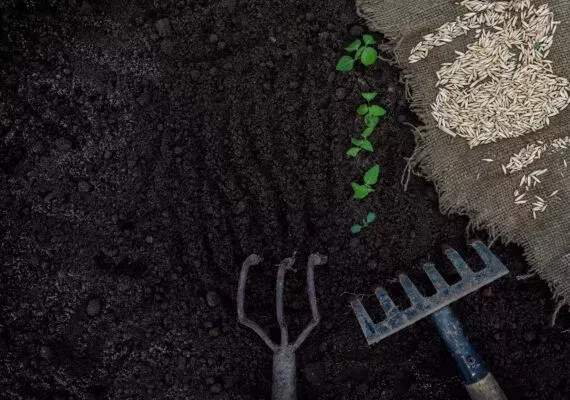
WHERE DO BLACK SOILS OCCUR IN POLAND?
Black soils are zonal soils. They can be found in the transitional zone of a warm temperate climate, where the annual precipitation ranges from 300 to 500 mm. The occurrence of soils of this type has been noted worldwide – in Hungary, Ukraine, the United States, Argentina, and Australia, as well as in Asia.
They also occur in Poland. They occupy about 1% of the country’s area – they are present in the Lublin Upland, Kielce-Sandomierz Upland, the so-called foothills of the Carpathians and the Sudetes in the areas of Hrubieszów, Proszowice, Prudnik, Przemyśl, and Sandomierz.
CHARACTERISTICS OF BLACK SOILS AND THEIR PROPERTIES
Black soils are formed without the influx of groundwater and material from the outside. The process of humification predominates in them. Therefore, they are classified as autonomous soils.
Where do black soils most often form?
Black soils are very fertile soils. They have a deep, black humus layer. Their formation is closely related to the occurrence of steppe vegetation and rocks rich in calcium (in the form of calcium carbonate). Therefore, they occur mainly on loess or loess-like dust.
How does the black soil process work?
Black soils are formed as a result of a soil-forming process called blackening. It consists of grasses (mainly their decomposing roots) being a source of significant amounts of matter. They thus supply the upper part of the soil profile. It looks like this: every year, grass vegetation provides several tons of dry organic matter per hectare. Thanks to this, new material appears equal to or exceeding that which has decomposed. All this shapes a deep humus layer. It can contain both fresh organic matter and that which has already been humified. Thanks to the elements from decomposing plants (sulfur, phosphorus, potassium, magnesium, and calcium), as well as carbonates present in the parent rock, black soil is richly saturated with nutrients.
Black soil most often has a profile consisting of layers such as:
- deep humus layer (40-100 cm)
- transitional layer
- parent rock
It also happens that below the transitional layer, there is also a brownish or illuvial layer.
Black soils owe their color to humic and humic acids. As for the soil acidity, the pH of black soils usually ranges from slightly acidic to slightly alkaline. The humus layer usually contains several percent of humus, up to a maximum of 10% or slightly above this value. The soil has a crumbly structure, which is beneficial for plant growth.
Do black soils have high humus and nutrient content?
Black soils are soils that have very good both physical and chemical properties. Thanks to this, they yield high yields. They also contain large amounts of elements such as potassium, magnesium, and calcium. They are highly saturated with alkaline cations (depending on the degree of their degradation, it can be from 50% to 90%). In addition to this, black soils are rich in iron, manganese, copper, and zinc.
What water-air conditions characterize black soils?
Black soils have good water-air conditions. They are permeable, while also retaining rainwater well. They are classified as very good wheat complexes. Heavily degraded black soils are classified as good wheat complexes, but they require mineral and organic fertilization.
What plants can grow on black soils, and which cannot?
Black soils are soils with the best agricultural properties in Poland. Among other things, you can grow on them:
- sugar beets
- wheat
- corn
- hemp
- sunflower
- rape
However, it is necessary to take into account the need for proper and rational management of these soils. Monoculture plantings can lead to erosion of black soils and a decrease in their fertility. Unfortunately, this phenomenon affects soil fertility in Poland.
There are no contraindications to planting other plants on black soils, but due to their high saturation with nutrients, plants with the highest nutritional requirements are chosen.

Podtypy czarnoziemów
Czarnoziemy można podzielić na: niezdegradowane, zdegradowane, leśne słabo zdegradowane, leśne silnie zdegradowane, namyte lub deluwialne oraz zmywane. W zależności od potrzeb rolnika i uprawy konkretnych roślin konieczna jest odpowiednia rekultywacja gleby.
Czarnoziemy niezdegradowane
Czarnoziemy niezdegradowane znajdują się na niewielkim obszarze naszego kraju. Dobrze rosną na nich lasy liściaste, rośliny lubiące wapń, a także trawy kserofilne. Ten podtyp czarnoziemów powstał z lessów, które są bogate w węglany. Górna warstwa poziomu próchnicznego ma odczyn obojętny lub słabo zasadowy. Czarnoziemy niezdegradowane nie mają poziomu iluwialnego i brunatnienia. Występują w nich niedobory żelaza, a próchnica ma silne związki kationów wapnia.
Czarnoziemy zdegradowane
Czarnoziemy zdegradowane powstają z udziałem roślinności leśnej. Odczyn tej gleby rośnie wraz z głębokością. Dzieje się tak z powodu wymywania związków zasadowych do poziomu iluwialno-węglanowego. Wyróżnia się czarnoziemy słabo i silnie zdegradowane. Degradację powoduje uprawa rolna gleby.
Czarnoziemy leśne słabo zdegradowane
Czarnoziemy leśne słabo zdegradowane mają profil złożony ze ściółki nakładowej. Składa się ona z substancji organicznej, która jest świeża i ulega szybkiemu rozkładowi, a także humifikacji. Poziom próchniczny ma ciemnoszary odcień i dochodzi do 60 cm. Następne są poziomy przejściowy oraz iluwialno-węglanowy.
Czarnoziemy leśne silnie zdegradowane
Czarnoziemy leśne silnie zdegradowane mają w swoim profilu warstwę próchnicy nadkładowej. Jest ona słabo zhumifikowana. Poziom próchniczny ma od 35 do 50 cm i jest szarego koloru. Zawiera około 3% próchnicy, mastrukturę gruzełkowatą.
Czarnoziemy namyte lub deluwialne
Czarnoziemy namyte lub deluwialne powstają, gdy podczas erozji u podnóży wzniesień osadzają się cząsteczki mineralne. Gleby te są bardzo bogate w składniki pokarmowe i mają wysoką przydatność rolniczą. Ich poziom próchniczny w swojej miąższości może przekraczać nawet 100 cm.
Czarnoziemy zmywane
Czarnoziemy zmywane są nazywane glebami w stadium przejściowym czarnoziemów i gleb brunatnych. Powstają na lessowych terenach i mają małą miąższość poziomu próchniczego. Można znaleźć je na górnej części stoku, w miejscach, które ulegają wodnej erozji.






